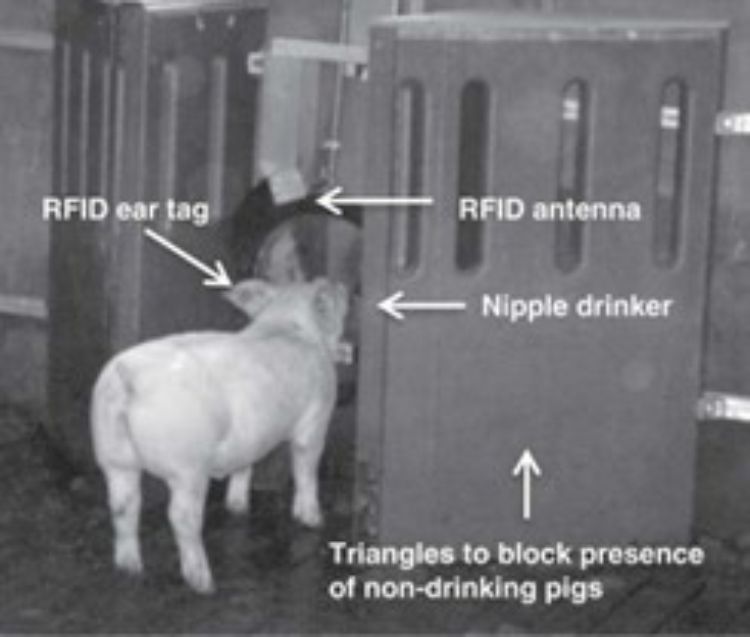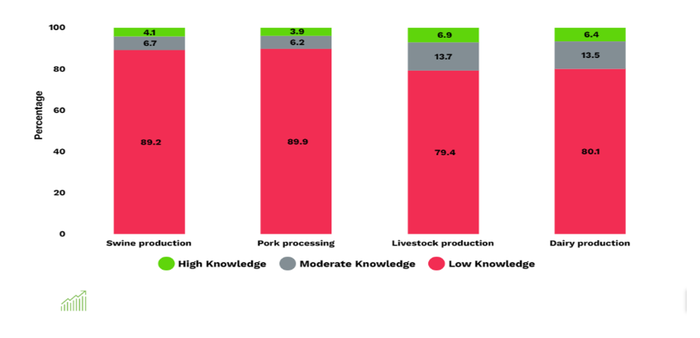What is the U.S. public perception of precision livestock farming?
Disconnect between swine producers and pork consumers; many have little idea of what it takes to raise a pig.
March 12, 2024

By Babatope Akinyemi and Janice Siegford, Michigan State University Department of Animal Science
A combination of increasing labor costs and shortages, increasing requirements for reducing environmental impact, narrow or uncertain profit margins, and growing public interest in how pigs are raised require innovative solutions by the pork industry. At the same time, we live in a world where there is a disconnect between swine producers and pork consumers, and many people have little idea of what it takes to raise a pig. This makes it important to understand how the public might view changes to farming practices before they happen.
For example, if pigs are managed using more technology, will people agree with this? Technologies that allow producers to predict or prevent problems or to care for each pig individually might reassure the public that pigs are well cared for and encourage them to keep buying pork products. On the other hand, technology is often seen as unnatural, which could reduce the attractiveness of even bacon. Which way will the public fall on this issue? Will they view using technology as a better way to care for pigs? Or will they be offended that robots and cameras are replacing human contact with pigs?
To get the answer to these questions before swine management technologies become widely adopted, we have asked the public how they feel about precision livestock farming technologies. PLF tools are intended to monitor pigs continuously, in real time and to provide information (like whether a pig is getting sick) or even to carry out actions using that information (like sorting a pig for treatment). PLF technologies are rapidly being developed as solutions to address labor needs and animal welfare concerns.
Survey says …
In 2023, Michigan State University surveyed 1,227 Americans to learn whether they know about farm animal production, their opinions on animal welfare, and their views on PLF technologies. Just over half of survey takers were female and respondents’ average age was 50 years old. Approximately 17% said they had some experience with livestock farming, while 44% reported they had friends or relatives involved in livestock production. Less than 10% of survey takers felt they were highly knowledgeable about livestock production, with 6% saying they felt highly knowledgeable about dairy production and fewer (4%) saying they knew about swine production and pork processing. Most (90%) said the welfare of farm animals was very important to them, and 80% said they were willing to pay a premium price to improve farm animals’ welfare.

MSU
Does the public believe the hype?
Companies making PLF and researchers working on this type of technology see many possible ways that PLF could improve life on the farm for pigs and their caretakers. To determine if these positive outcomes resonate with the American public, survey participants were asked about a range of likely benefits of using PLF for pigs, farmers, swine production, consumers and the environment. The biggest takeaway from our findings is that roughly half of survey takers were not sure if PLF would have positive outcomes such as lowering cost of production, improving pig health or increasing how much pork was produced.

MSU
Will PLF distance farmers from their animals?
Questions have been raised about the possibility that PLF might reduce the concern farmers have for their animals and make them less caring. Nearly 60% of survey takers were not sure if this would be the case while 23% did not see PLF separating caregivers from their pigs. However, 19% of the Americans in this study shared this concern, which needs be remembered if (when) PLF is adopted. One way a disconnect between producers and pigs could be avoided is if PLF frees the producer from mundane, repetitive work and allows them to spend more time with their pigs or caring for pigs with unique needs.
How will PLF affect pork production and price?
PLF is thought to mainly benefit large-scale commercial farms where individual care of large numbers of pigs by few human caretakers is practically impossible. A concern surrounding PLF is that these technologies could push producers to raise even more pigs on the same farm or at a higher densities. About 30% of survey takers did feel PLF adoption would lead to increased pork production (i.e., more pigs on more farms), while just over half were unsure about PLF's impact on pork production.
For pork producers, PLF’s potential to reduce input and labor costs and thereby reduce the cost of raising pigs is a key piece of the puzzle when deciding to add technology to the farm. A third of Americans who participated in this study felt that PLF could lower pork price, while 57% were uncertain about how PLF would affect pork price.
Will PLF improve farmers’ quality of life?
Supporters of PLF often stress its ability to simplify and automate routine work and make caregivers' work easier and safer, improving their quality of life. About 36% of our survey respondents thought PLF could improve the welfare of farmers, while 53% were unsure how PLF might benefit human users. However, more technology is not the answer for everyone, and 10% of respondents disagreed that PLF would improve the lives of people working on farm.
Will PLF improve animal health and welfare?
Improving pigs’ physical health and their overall welfare using real-time monitoring throughout their lives are two of PLF's most frequently discussed benefits. However, only about half of the people answering the survey felt PLF would actually improve either a pig’s health or its overall quality of life. Nearly half of participants who completed the survey weren’t sure what impact PLF would have on the pigs’ health but few thought that PLF would worsen a pig’s pig health or welfare.

MSU
Will PLF bring farmers and consumers closer?
PLF could help bridge the gap between farmers and consumers by making it easier to trace pork products or to create transparent labeling. However, most people who took the survey (56%) still need to be convinced that this could happen. However, three times as many people agreed that this could be a possible benefit of PLF (35%) compared to those that disagreed (9%).
Is PLF environmentally friendly?
Another possible benefit of PLF is that it could reduce the impact of animal agriculture on the environment. For instance, PLF could help with efficient feeding using targeted nutrition, leading to less food waste or nutrient run-off. About 47% of Americans agree that PLF could be environmentally friendly, while an equal number remain uncertain about PLF’s environmental benefits. Very few respondents (6%) felt that PLF would be bad for the environment.
Conclusion
Fewer than one-fifth of Americans in this study had working experience in livestock farming, and only a few considered themselves knowledgeable about livestock, dairy, swine and pork production. Most of them thought the welfare of farm animals was important and were willing to pay more for animal products to improve the welfare of farm animals.
The fact that most survey takers were not sure how PLF could benefit pigs, farmers, consumers or the environment means it is unclear how the American public might react to this type of technology on swine farms. Familiarizing Americans with the PLF technologies on U.S. swine farms might help them appreciate the measures being put in place by swine producers to care for their pigs, meet regulatory requirements, and address public concerns. Even more importantly, being open, honest and respectful of the public’s concerns related to PLF while trying to overcome them is key to maintaining trust with people who buy pork products. Capitalizing on the positive attributes people feel PLF can bring to the farm is strategy that could be used by the swine industry to boost sales of pork when such technology is used on farm.
This study was supported by the Michigan Alliance for Animal Agriculture, M-AAA Proposal ID: AA-22-0044.
You May Also Like



